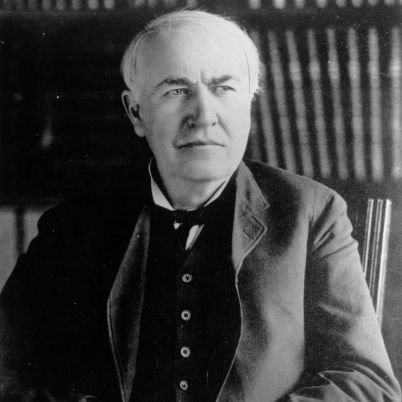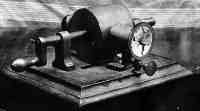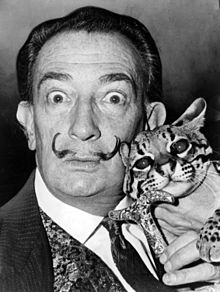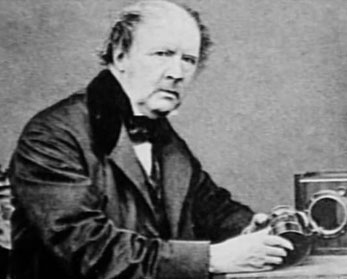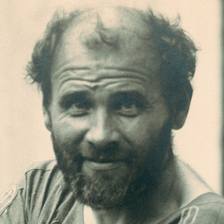Thomas Edison held a world record of 1093 patents for inventions such as the lightbulb and phonograph
He was born on February 11, 1847 in Milan, Ohio; the seventh and last child of Samuel and Nancy Edison.
Edison was an American inventor, scientist and businessman who developed many devices that greatly influenced life around the world, including the phonograph, the motion picture camera, and a long-lasting, practical electric light bulb.
Dubbed “The Wizard of Menlo Park” (now Edison, New Jersey) by a newspaper reporter, he was one of the first inventors to apply the principles of mass production and large teamwork to the process of invention, and therefore is often credited with the creation of the first industrial research laboratory.
Edison is considered one of the most prolific inventors in history, holding 1,093 U.S. patents in his name, as well as many patents in the United Kingdom, France and Germany. He is credited with numerous inventions that contributed to mass communication and, in particular, telecommunications. His advanced work in these fields was an outgrowth of his early career as a telegraph operator.
Edison originated the concept and implementation of electric-power generation and distribution to homes, businesses, and factories – a crucial development in the modern industrialized world. His first power station was on Manhattan Island, New York.
The first great invention developed by Edison in Menlo Park was the tin foil phonograph. While working to improve the efficiency of a telegrsph transmitter, he noted that the tape of the machine gave off a noise resembling spoken words when played at a high speed. This caused him to wonder if he could record a telephone message. He began experimenting with the diaphragm of a telephone receiver by attaching a needle to it. He reasoned that the needle could prick paper tape to record a message. His experiments led him to try a stylus on a tinfoil cylinder, which, to his great surprise, played back the short message he recorded, “Mary had a little lamb.”
The word phonograph was the trade name for Edison’s device, which played cylinders rather than discs. The machine had two needles: one for recording and one for playback. When you spoke into the mouthpiece, the sound vibrations of your voice would be indented onto the cylinder by the recording needle. This cylinder phonograph was the first machine that could record and reproduce sound created a sensation and brought Edison international fame.
Electricity and Lightbulb – History
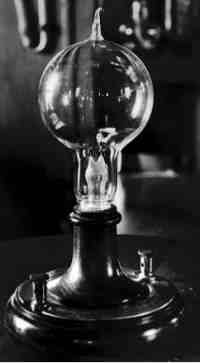 Thomas Edison’s greatest challenge was the development of a practical incandescent, electric light. Contrary to popular belief, he didn’t “invent” the lightbulb, but rather he improved upon a 50-year-old idea. In 1879, using lower current electricity, a small carbonized filament, and an improved vacuum inside the globe, he was able to produce a reliable, long-lasting source of light. The idea of electric lighting was not new, and a number of people had worked on, and even developed forms of electric lighting. But up to that time, nothing had been developed that was remotely practical for home use. Edison’s eventual achievement was inventing not just an incandescent electric light, but also an electric lighting system that contained all the elements necessary to make the incandescent light practical, safe, and economical. After one and a half years of work, success was achieved when an incandescent lamp with a filament of carbonized sewing thread burned for thirteen and a half hours.
Thomas Edison’s greatest challenge was the development of a practical incandescent, electric light. Contrary to popular belief, he didn’t “invent” the lightbulb, but rather he improved upon a 50-year-old idea. In 1879, using lower current electricity, a small carbonized filament, and an improved vacuum inside the globe, he was able to produce a reliable, long-lasting source of light. The idea of electric lighting was not new, and a number of people had worked on, and even developed forms of electric lighting. But up to that time, nothing had been developed that was remotely practical for home use. Edison’s eventual achievement was inventing not just an incandescent electric light, but also an electric lighting system that contained all the elements necessary to make the incandescent light practical, safe, and economical. After one and a half years of work, success was achieved when an incandescent lamp with a filament of carbonized sewing thread burned for thirteen and a half hours.
There are a couple of other interesting things about the invention of the light bulb: While most of the attention was on the discovery of the right kind of filament that would work, Edison actually had to invent a total of seven system elements that were critical to the practical application of electric lights as an alternative to the gas lights that were prevalent in that day.
Younger Years
Born in Milan, Ohio, Thomas Alva Edison was the last of the seven children of Samuel and Nancy Edison. Thomas’s father was an exiled political activist from Canada. His mother, an accomplished school teacher, was a major influence in Thomas’ early life. An early bout with scarlet fever left him with hearing difficulties in both ears, a malady that would eventually leave him nearly deaf as an adult.
In 1854, the family moved to Port Huron, Michigan, where Edison attended public school for a total of 12 weeks. A hyperactive child, prone to distraction, he was deemed “difficult” by his teacher. His mother quickly pulled him from school and taught him at home. At age 11, he showed a voracious appetite for knowledge, reading books on a wide range of subjects. In this wide-open curriculum Edison developed a process for self-education and learning independently that would serve him throughout his life.
Early Career
At age 12, Edison set out to put much of that education to work. He convinced his parents to let him sell newspapers to passengers along the Grand Trunk Railroad line. Exploiting his access to the news bulletins teletyped to the station office each day, Thomas began publishing his own small newspaper, called the Grand Trunk Herald. The up-to-date articles were a hit with passengers. This was the first of what would become a long string of entrepreneurial ventures where he saw a need and capitalized on opportunity.
Edison also used his access to the railroad to conduct chemical experiments in a small laboratory he set up in a train baggage car. During one of his experiments, a chemical fire started and the car caught fire. The conductor rushed in and struck Thomas on the side of the head, probably furthering some of his hearing loss. He was kicked off the train and forced to sell his newspapers at various stations along the route.
While he worked for the railroad, a near-tragic event turned fortuitous for the young man. After Edison saved a three-year-old from being run over by an errant train, the child’s grateful father rewarded him by teaching him to operate a telegraph. By age 15, he had learned enough to be employed as a telegraph operator. For the next five years, Edison traveled throughout the Midwest as an itinerant telegrapher, subbing for those who had gone to the Civil War. In his spare time, he read widely, studied and experimented with telegraph technology, and became familiar with electrical science.
In 1866, at age 19, Edison moved to Louisville, Kentucky, working for The Associated Press.
The night shift allowed him to spend most of his time reading and experimenting. He developed an unrestrictive style of thinking and inquiry, proving things to himself through objective examination and experimentation. Initially, Edison excelled at his telegraph job because early Morse code was inscribed on a piece of paper, so Edison’s partial deafness was no handicap. However, as the technology advanced, receivers were increasingly equipped with a sounding key, enabling telegraphers to “read” message by the sound of the clicks. This left Edison disadvantaged, with fewer and fewer opportunities for employment.
In 1868, Edison returned home to find his beloved mother was falling into mental illness and his father was out of work. The family was almost destitute. Edison realized he needed to take control of his future. Upon the suggestion of a friend, he ventured to Boston, landing a job for the Western Union Company. At the time, Boston was America’s center for science and culture, and Edison reveled in it. In his spare time, he designed and patented an electronic voting recorder for quickly tallying votes in the legislature. However, Massachusetts lawmakers were not interested. As they explained, most legislators didn’t want votes tallied quickly. They wanted time to change the minds of fellow legislators.
Becoming an Inventor
In 1869, Edison moved to New York City and developed his first invention, an improved stock ticker, the Universal Stock Printer, which synchronized several stock tickers’ transactions. The Gold and Stock Telegraph Company was so impressed, they paid him $40,000 for the rights. Edison was only 22 years old. With this success, he quit his work as a telegrapher to devote himself full-time to inventing.
In 1870, Thomas Edison set up his first small laboratory and manufacturing facility in Newark, New Jersey, and employed several machinists. As an independent entrepreneur, Edison formed numerous partnerships and developed his products for the highest bidder. Often that was Western Union Telegraph Company, the industry leader, but just as often, it was one of Western Union’s rivals. In one such instance, Edison devised for Western Union the quadruplex telegraph, capable of transmitting two signals in two different directions on the same wire, but railroad tycoon Jay Gould snatched the invention from Western Union, paying Edison more than $100,000 in cash, bonds and stock, and generating years of litigation.
With his ever-increasing financial success, in 1871 Edison married 16-year-old Mary Stilwell, who was an employee at one of his businesses. During their 13-year marriage, they had three children, Marion, Thomas and William, who became an inventor. Mary died of a suspected brain tumor at the age of 29 in 1884.
By the early 1870s, Thomas Edison had acquired a reputation as a first-rate inventor. In 1876, he moved his expanding operations to Menlo Park, New Jersey, and built an independent industrial research facility incorporating machine shops and laboratories.
That same year, Western Union encouraged him to develop a communication device to compete with Alexander Graham Bell’s telephone. He never did. However, in December of 1877, Edison developed a method for recording sound: the phonograph. Though not commercially viable for another decade, the invention brought him worldwide fame.
Edison Illuminating Company
The 1880s were a busy time for Thomas Edison. After being granted a patent for the light bulb in January 1880, Edison set out to develop a company that would deliver the electricity to power and light the cities of the world. That same year, Edison founded the Edison Illuminating Company—the first investor-owned electric utility—which later became the General Electric Corporation. In 1881, he left Menlo Park to establish facilities in several cities where electrical systems were being installed. In 1882, the Pearl Street generating station provided 110 volts of electrical power to 59 customers in lower Manhattan. In 1884 Edison’s wife, Mary, died, and in 1886 he married Mina Miller, 19 years his junior. In 1887, Edison built an industrial research laboratory in West Orange, New Jersey, which served as the primary research laboratory for the Edison lighting companies. He spent most of his time there, supervising the development of lighting technology and power systems. He also perfected the phonograph, and developed the motion picture camera and the alkaline storage battery.
Industrialist and Business Manager
During the next few decades, Edison found his role as inventor transitioning to one as industrialist and business manager. The laboratory in West Orange was too large and complex for any one man to completely manage, and Edison found he was not as successful in his new role as he was in his former one. Edison also found that much of the future development and perfection of his inventions was being conducted by university-trained mathematicians and scientists. He worked best in intimate, unstructured environments with a handful of assistants and was outspoken about his disdain for academia and corporate operations.
On a couple of occasions, Edison was able to turn failure into success. During the 1890s he built a magnetic iron-ore processing plant in northern New Jersey that proved to be a commercial failure. Later, he was able to salvage the process into a better method for producing cement. As the automobile industry began to grow, Edison worked on developing a suitable storage battery that could power an electric car. Eventually, the gasoline-powered engine prevailed, but in 1912 Edison designed a battery for the self-starter on the Model T for friend and admirer Henry Ford. The system was used extensively in the auto industry for decades.
During World War I, the U.S. government asked Thomas Edison to head the Naval Consulting Board, which examined inventions submitted for military use. Edison worked on several projects, including submarine detectors and gun-location techniques. However, due to his moral indignation toward violence, he specified that he would work only on defensive weapons, later noting, “I am proud of the fact that I never invented weapons to kill.”
By the end of the 1920s Thomas Edison was in his 80s and he slowed down somewhat, but not before he applied for the last of his 1,093 U.S. patents, for an apparatus for holding objects during the electroplating process. Edison and his second wife, Mina, spent part of their time at their winter retreat in Fort Myers, Florida, where his friendship with automobile tycoon Henry Ford flourished and he continued to work on several projects,ranging from electric trains to finding a domestic source for natural rubber.
Final Years
Thomas Edison died of complications of diabetes on October 18, 1931, in his home, “Glenmont,” in West Orange, New Jersey. He was 84 years old. Many communities and corporations throughout the world dimmed their lights or briefly turned off their electrical power to commemorate his passing. Edison’s career was the quintessential rags-to-riches success story that made him a folk hero in America. An uninhibited egoist, he could be a tyrant to employees and ruthless to competitors. Though he was a publicity seeker, he didn’t socialize well and often neglected his family. By the time he died he was one of the most well-known and respected Americans in the world. He had been at the forefront of America’s first technological revolution and set the stage for the modern electric world.
Edison, considered one of America’s leading businessmen, is credited today for helping to build America’s economy during the nation’s vulnerable early years.
Credits:
http://www.biography.com/

